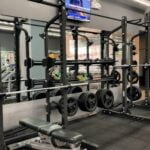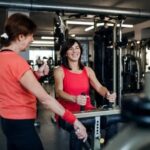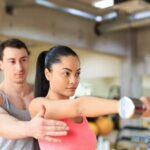As individuals age, staying physically active becomes increasingly vital to maintaining overall health and well-being. Engaging in keep fit exercises for the elderly is not just about staying in shape, but it also plays a crucial role in promoting independence, reducing the risk of chronic diseases, and enhancing quality of life. Regular physical activity can improve strength, flexibility, balance, and cardiovascular health, making daily tasks easier and lowering the likelihood of falls or injuries.
Exercise has numerous benefits for elderly individuals beyond just physical health. It can also have positive effects on mental health, boosting mood, cognitive function, and even sleep quality. Furthermore, staying active can provide opportunities for social interaction and participation in community activities, reducing feelings of isolation or loneliness that are common among seniors. By incorporating a variety of exercise routines tailored to their needs and abilities, older adults can maintain a sense of purpose and autonomy as they age gracefully.
Before starting an exercise routine, it is essential for seniors to consult with their healthcare provider to ensure that they are engaging in safe and appropriate activities. Factors such as existing medical conditions, medications being taken, or previous injuries should be taken into consideration when selecting the right type of exercises. With proper guidance and understanding of individual limitations, elderly individuals can begin a fitness regimen that suits their specific needs while avoiding potential risks or complications.
Benefits of Regular Exercise for Elderly Individuals
Regular exercise is crucial for the overall well-being of elderly individuals. Incorporating keep fit exercises for the elderly into their daily routine can have numerous benefits that contribute to a healthier and more active lifestyle. Here are some key advantages of regular physical activity for seniors:
- Improved cardiovascular health: Engaging in cardiovascular exercises such as walking, swimming, or cycling can help strengthen the heart and improve circulation, reducing the risk of heart disease and stroke.
- Enhanced strength and muscle tone: Strength training exercises like lifting weights or using resistance bands can help seniors build muscle mass, increase bone density, and improve overall strength to support daily activities.
- Increased flexibility and balance: Flexibility exercises such as yoga or gentle stretching can help seniors maintain joint mobility and prevent falls by improving balance and coordination.
In addition to these physical benefits, regular exercise can also have a positive impact on mental health in elderly individuals. Physical activity releases endorphins, also known as “feel-good” hormones, which can help reduce feelings of anxiety, depression, and stress. It also provides opportunities for social interaction and engagement, which are essential for maintaining cognitive function and emotional well-being in older adults.
Moreover, keep fit exercises for the elderly can help boost self-esteem and confidence by achieving personal fitness goals. Whether it’s increasing the number of steps taken each day or reaching a new personal best in strength training exercises, setting achievable objectives can provide a sense of accomplishment and motivation to continue with an active lifestyle. By focusing on the many benefits of regular exercise, seniors can stay motivated to prioritize their health and well-being through physical activity.
Factors to Consider Before Starting an Exercise Routine
Before embarking on any keep fit exercises for the elderly, it is crucial to consider certain factors to ensure safety and efficacy. Firstly, it is essential to consult with a healthcare provider or physician before starting any new exercise routine, especially for seniors with pre-existing medical conditions. This step can help in identifying any potential risks or limitations that need to be taken into account when designing a personalized exercise plan.
Another important factor to consider is the current fitness level of the elderly individual. Starting with low-impact exercises and gradually increasing intensity can help prevent injuries and build endurance over time. It is also important to set realistic goals and expectations based on individual abilities and limitations. Additionally, considering any physical limitations such as joint pain, arthritis, or mobility issues can help in selecting appropriate exercises that cater to specific needs.
Furthermore, it is crucial to create a safe environment for exercise by ensuring proper footwear, comfortable clothing, and adequate hydration during workouts. Seniors should also pay attention to warming up before each exercise session and cooling down afterward to prevent muscle strains or injuries. By taking these factors into consideration, elderly individuals can safely and effectively engage in keep fit exercises that promote overall health and well-being.
| Factors | Considerations |
|---|---|
| Consultation | Speak with healthcare provider before starting |
| Fitness Level | Begin with low-impact exercises and progress gradually |
| Limits & Goals | Set realistic goals based on individual abilities and limitations |
Cardiovascular Exercises for the Elderly
As individuals age, it becomes increasingly important for them to stay active and engage in regular exercise to maintain their overall health and well-being. Cardiovascular exercises are especially beneficial for the elderly population as they help improve heart health, increase stamina, and enhance quality of life.
These exercises can range from low-impact activities like walking or cycling to more vigorous exercises such as swimming or dancing. Regardless of the intensity level, incorporating cardiovascular exercises into their routine can significantly impact the physical and mental health of older adults.
Benefits of Cardiovascular Exercises for Seniors
Engaging in cardiovascular exercises offers a multitude of benefits for seniors. These activities help strengthen the heart and lungs, improve circulation, and reduce the risk of chronic diseases such as heart disease and diabetes. Additionally, regular cardiovascular exercise can lead to increased energy levels, better mood regulation, and improved cognitive function. For elderly individuals, maintaining a healthy cardiovascular system is crucial for overall vitality and longevity.
Recommended Cardiovascular Exercises for Older Adults
When considering keep fit exercises for the elderly, these recommendations should focus on low-impact activities that are gentle on joints while still providing a cardiovascular workout. Walking is an excellent form of exercise that can be easily incorporated into daily routines. Swimming or water aerobics are great options for those with joint pain or arthritis, as the water provides resistance without impacting the joints.
Cycling on a stationary bike or outdoors is another effective way for seniors to get their heart rate up while enjoying the outdoors. It’s essential to consult with a healthcare provider before starting any new exercise routine to ensure safety and proper guidance based on individual needs and health conditions.
Strength Training Exercises for Seniors
As we age, maintaining muscle strength becomes increasingly important for overall health and quality of life. Strength training exercises are a crucial component of any fitness routine for seniors, as they help to build and maintain muscle mass, bone density, and functional abilities. Incorporating strength training exercises can also help prevent falls, improve balance, enhance coordination, and increase metabolism. With the right guidance and proper technique, elderly individuals can safely engage in strength training to reap these benefits.
Benefits of Strength Training for Seniors
Strength training offers numerous benefits for older adults. It helps to preserve and enhance muscle mass, which naturally decreases with age due to hormonal changes and decreased physical activity. By building stronger muscles, seniors can maintain their ability to perform daily tasks independently and reduce the risk of injuries or accidents.
Additionally, strength training has been shown to improve cognitive function, mood, and overall well-being in older individuals. Regular resistance exercises can also support cardiovascular health by lowering blood pressure and improving circulation.
Best Practices for Strength Training
Before beginning a strength training program, it is important for seniors to consult with their healthcare provider or a fitness professional to ensure that the chosen exercises are safe and appropriate for their individual needs. Starting with light weights or resistance bands is recommended, gradually increasing the intensity as strength improves. It is essential to focus on form and technique during each exercise to prevent injury and maximize benefits.
Some common types of strength training exercises for seniors include bodyweight movements (like squats or lunges), resistance band exercises, free weights (dumbbells), or machine-assisted workouts. Remember to listen to your body’s signals and adjust the intensity or volume of exercise as needed.
By incorporating regular strength training exercises into their routine, elderly individuals can enjoy improved physical function, enhanced mobility, better posture, increased independence, and a higher quality of life overall. It is never too late to start reaping the benefits of strength training – whether it’s at home with basic equipment or in a fitness class specifically designed for seniors.
With consistency and dedication, older adults can maintain strong muscles and joints that support them in their daily activities as they age gracefully.
Flexibility and Balance Exercises for Improved Mobility
As we age, maintaining flexibility and balance becomes increasingly important for overall mobility and independence. Engaging in regular flexibility and balance exercises can help prevent falls, improve posture, and enhance coordination in elderly individuals. These exercises are essential for keeping the body agile and flexible, reducing the risk of injury due to stiffness or loss of balance.
One of the key benefits of incorporating flexibility and balance exercises into a senior’s routine is the preservation of joint health. By regularly stretching and working on balancing techniques, older adults can maintain their range of motion in joints, which is crucial for performing daily activities with ease. Additionally, these exercises can also help alleviate any discomfort or pain associated with arthritis or other age-related conditions.
Some examples of flexibility exercises for seniors include gentle stretches targeting major muscle groups such as the neck, shoulders, back, hips, and legs. Activities like yoga or tai chi are excellent options that focus on improving flexibility while promoting relaxation and stress relief.
On the other hand, balance exercises like standing on one leg or heel-to-toe walking can help strengthen core muscles and improve overall stability, reducing the risk of falls. By incorporating these types of exercises into their routine, elderly individuals can enhance their mobility and lead a more active lifestyle.
Chair Exercises for Those With Limited Mobility
As we age, maintaining an active lifestyle becomes increasingly important for overall health and well-being. For elderly individuals with limited mobility, engaging in keep fit exercises for the elderly can significantly improve quality of life. Chair exercises are a great option for those who may have difficulty standing or moving around freely.
Here are some chair exercises that can help seniors stay fit and healthy:
- Seated Marching: Sit upright in a sturdy chair and lift your knees up one at a time as if you were marching in place. This exercise helps improve circulation and strengthen the lower body.
- Chair Yoga: Practice gentle yoga poses adapted for sitting on a chair to improve flexibility, reduce stiffness, and promote relaxation.
- Arm Circles: Sit comfortably in your chair and extend your arms out to the sides. Make small circular motions with your arms, gradually increasing the size of the circles. This exercise helps improve shoulder mobility and strength.
Regularly incorporating these chair exercises into a daily routine can help seniors maintain or improve their physical abilities, boost their mood, and increase their energy levels. It’s essential to consult with a healthcare provider before starting any new exercise program, especially for individuals with pre-existing health conditions or mobility issues. By making small but consistent efforts to stay active, elderly individuals can reap the numerous benefits of regular exercise while improving their overall quality of life.
Tips for Staying Motivated and Consistent With Exercise Routines
As individuals grow older, maintaining an active lifestyle becomes crucial for overall health and well-being. Regular exercise not only helps improve physical health but also boosts mental wellness in the elderly. It is essential to incorporate keep fit exercises for the elderly into their daily routine to ensure they stay healthy and independent as they age.
One of the key benefits of regular exercise for elderly individuals is improved cardiovascular health. Cardiovascular exercises such as walking, cycling, or swimming help strengthen the heart and improve circulation, reducing the risk of heart disease and stroke. These exercises also increase endurance and energy levels, making day-to-day activities easier to manage for seniors.
In addition to cardiovascular exercises, strength training plays a vital role in maintaining muscle mass and bone density in seniors. Simple exercises using resistance bands or light weights can help prevent muscle loss and reduce the risk of falls and fractures.
It is important for elders to focus on both cardio and strength training exercises to improve overall physical function and maintain independence in their daily lives. By incorporating a variety of keep fit exercises for the elderly, seniors can enjoy a higher quality of life and age gracefully with confidence.
Conclusion
In conclusion, it is clear that incorporating keep fit exercises for the elderly into their daily routines can significantly improve their overall health and well-being. Regular physical activity not only helps to maintain muscle strength and flexibility but also plays a crucial role in preventing chronic conditions such as heart disease, diabetes, and arthritis. By staying active, seniors can enjoy a higher quality of life with increased independence and mobility.
It is essential for elderly individuals to consult with their healthcare providers before starting any exercise routine to address any underlying health concerns or limitations. By taking necessary precautions and adapting exercises to suit individual needs, seniors can safely engage in various forms of physical activity. Whether it’s cardiovascular exercises, strength training, flexibility workouts, or chair exercises for those with limited mobility, there are plenty of options available to help older adults stay fit and healthy.
Furthermore, staying motivated and consistent with exercise routines is key to reaping the full benefits of physical activity. Setting realistic goals, tracking progress, and finding enjoyable activities are all strategies that can help older adults stay on track with their fitness goals. By empowering the elderly to prioritize their health and well-being through regular exercise, we can support them in leading fulfilling and active lifestyles well into their golden years.
Frequently Asked Questions
What Is the Number One Exercise for Seniors?
The number one exercise for seniors is walking. It is low-impact, easy on the joints, and can be done at a pace that suits individual fitness levels. Walking also improves cardiovascular health and helps to maintain mobility.
What Is the Best Workout Routine for Seniors?
The best workout routine for seniors usually includes a combination of exercises that focus on strength, balance, flexibility, and cardiovascular health. This could involve activities such as walking, swimming, light weightlifting, yoga, or tai chi. It’s important to consult with a healthcare provider before starting any new exercise routine.
What Is the Best Way for Elderly People to Stay Fit?
The best way for elderly people to stay fit is to engage in regular physical activity that they enjoy and can safely perform. This could include activities like water aerobics, gardening, dancing, or even chair exercises.
Staying active helps maintain muscle strength, flexibility, balance, and overall well-being. Additionally, incorporating proper nutrition and staying hydrated are essential components of staying fit as an elderly person.

Passionate about providing useful information to anyone with an interest in the field of Personal Training, I strive to pass on to our readers quality information and to answer any questions about Personal Trainers, the work they do and how to become one.





